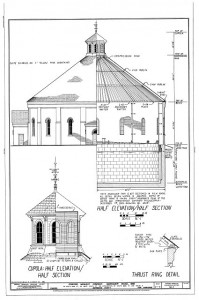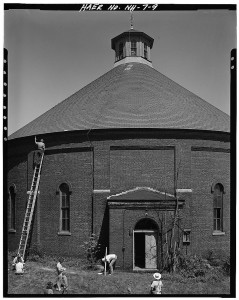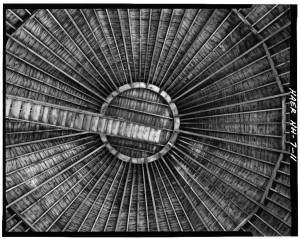CONCORD N. H. GASHOLDER FACES UNCERTAIN FUTURE
 After more than two years of apparent inaction, owner Liberty Utilities has recently announced that it will soon decide whether to repair or demolish the well-known but damaged gasholder house in Concord, N. H. The 1888 brick structure is the last gasholder house in the United States to retain its interior floating tank. The building serves as the logo of the Northern New England Chapter of the Society for Industrial Archeology (SIA).
After more than two years of apparent inaction, owner Liberty Utilities has recently announced that it will soon decide whether to repair or demolish the well-known but damaged gasholder house in Concord, N. H. The 1888 brick structure is the last gasholder house in the United States to retain its interior floating tank. The building serves as the logo of the Northern New England Chapter of the Society for Industrial Archeology (SIA).
Built for the Concord Gas Light Company (founded 1850) to supplant smaller gasholders with lesser capacities, the 1888 structure is 86 feet in diameter and 28 feet high to the top of its brick walls, and had a maximum storage capacity of 120,000 cubic feet. The riveted gasholder tank weighs 80,000 pounds and floated in a subterranean cistern holding 800,000 gallons of water. W. C. Whyte of New York City built the structure, and Laurel Iron Works of Philadelphia fabricated its enclosed wrought iron tank. Both companies were specialists in gasholder design and construction.
The Concord gasholder house was the site of the inaugural meeting of the Northern New England Chapter of SIA on July 26, 1980. Two years later, the chapter recorded the building for the Historic American Engineering Record (HAER) with a 25-member team assembled by the late William L. Taylor of Plymouth State College, now PSU. Chief of HAER Eric DeLony and Smithsonian curator Robert M. Vogel advised the crew, and a survey and planning grant from the New Hampshire State Historic Preservation Office provided financial support. Taylor published a summary history of the gas company and the gas holder in the SIA journal IA 10:1 (1984): 1-16.
The gasholder stored coal gas until 1894, followed by carbureted water gas until 1952, when the then-owners switched from manufactured gas to natural gas.
Although unused, the building remained in excellent condition until 2013, when a storm-toppled tree crushed a section of its conical wood-framed and slated roof. The impact damaged the wooden thrust ring at the base of the roof and the supporting masonry wall below. The owners left the roof unrepaired as winter approached, prompting the New Hampshire Preservation Alliance to declare the gasholder house one of the seven most endangered historic properties in the state in October 2013.
Liberty Utilities hired a contractor to place a temporary patch on the roof in September 2014, but a year later has announced that the temporary work is at the end of its effective life and that the company must soon decide whether to restore the building or to demolish it and clean up the site. Local officials regard the building as an icon of the New Hampshire state capital and are hoping to meet with Liberty Utilities representatives to seek a way to preserve the structure.
[This article was written by PSU Historic Preservation professor James Garvin and originally published in the Fall 2015 (Vol. 36, No. 2) newsletter of the Society for Industrial Archeology – New England Chapters.]


